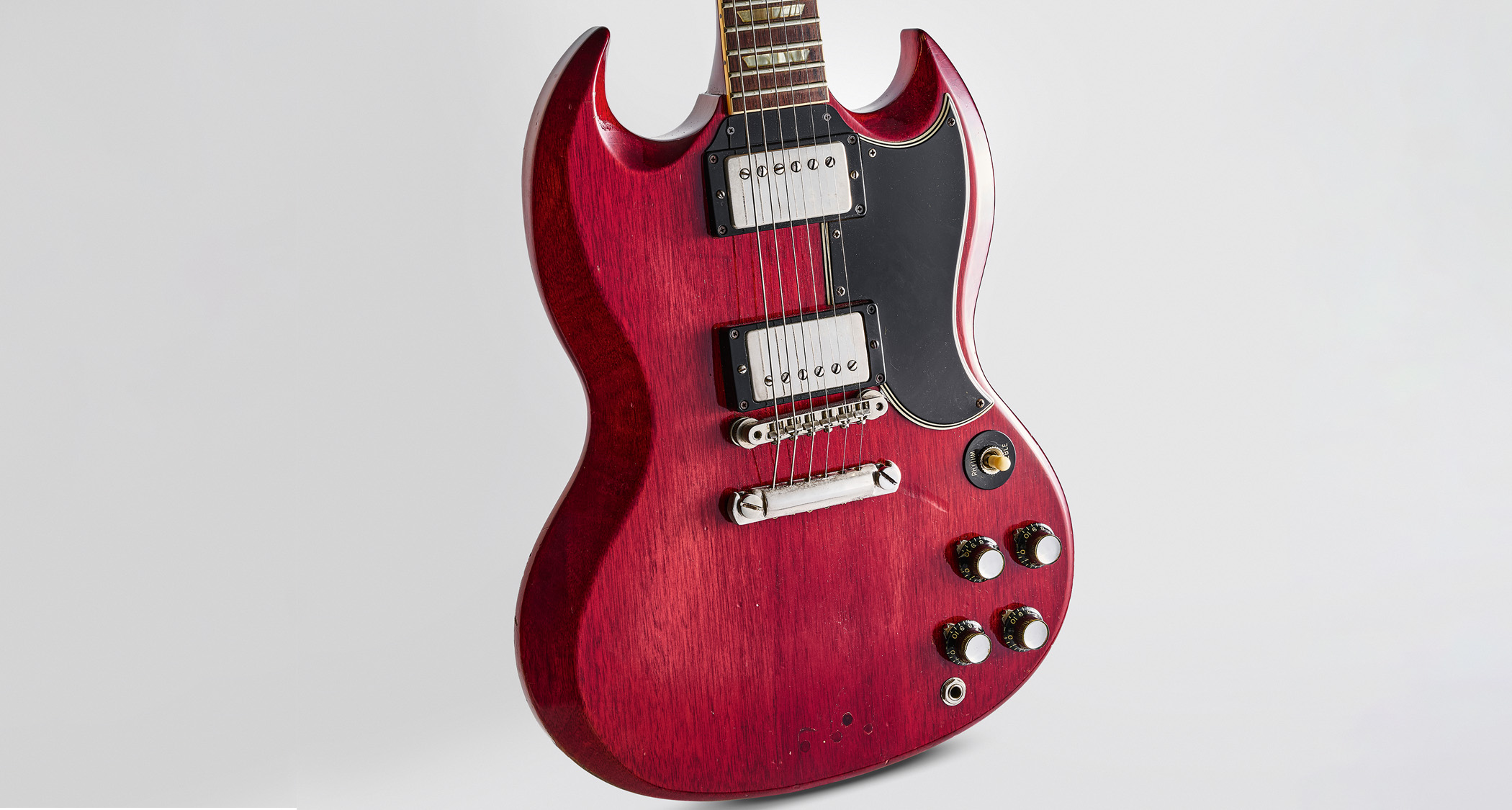“My Foo Fighters setup is the kind of beast you have when somebody carries your s**t around for you!” Chris Shiflett on his double-life as a jobbing solo artist and lead guitarist in the world’s biggest rock band
The Foo Fighters stalwart tells us about the “blasphemy” of his new backline, holding his breath when he solos and why the kind of guitar playing he loved “became pretty much illegal”
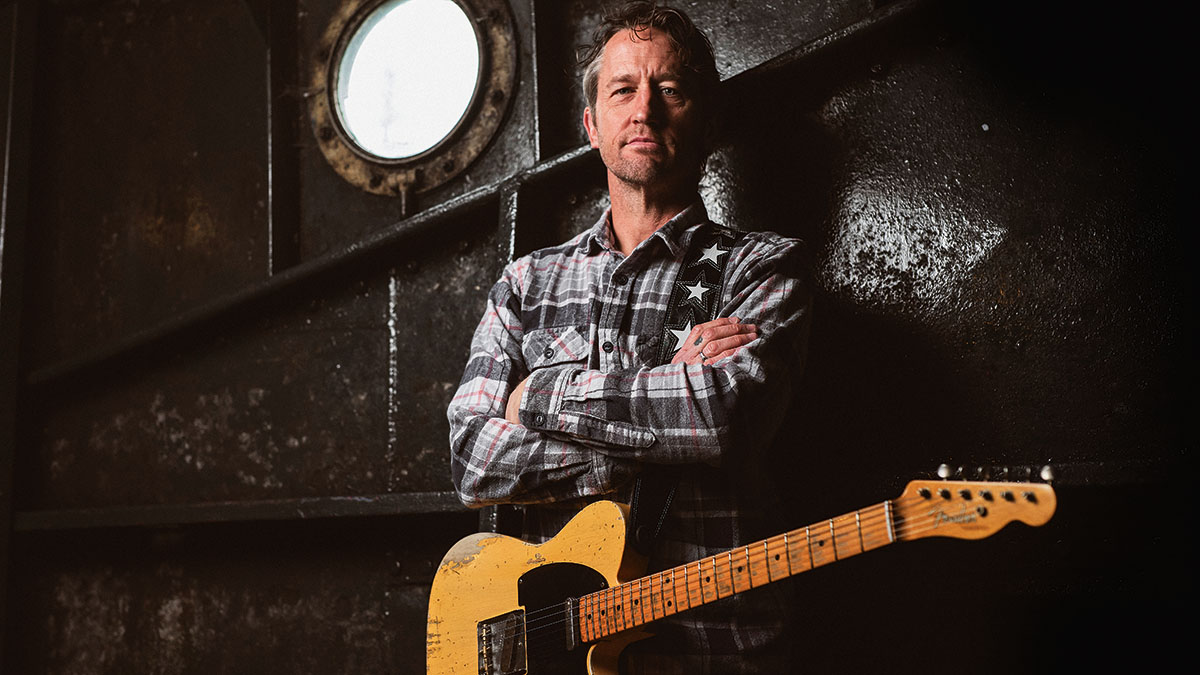
Chris Shiflett has the best kind of identity crisis. Back in 1999, when the 28-year-old Californian won out at auditions to become lead guitarist for the Foo Fighters – a triumph he succinctly put down to “learning the fucking songs” – it seemed this one-time punk rabble-rouser had forever traded the sticky-floored basements and roiling circle pits for corporate-sponsored stadiums and catering.
But since then – and with the exception of the band’s Duracell Bunny-ish leader, Dave Grohl – Shiflett has been the busiest Foo in the firmament, juggling the day job with de facto solo projects The Dead Peasants and Jackson United, a fistful of albums under his own name, plus shifts in larky covers outfit Me First And The Gimme Gimmes. “There’s nothing better than those big Foos shows,” he once told this writer. “But equally, Dingwalls is fun, too.”
Depending on the day you catch him, Shiflett is either a star or a slogger, a tech-assisted princeling or a man unloading his own flight cases, spotted backstage at Wembley Stadium or – on this particular afternoon – setting up at Bristol’s 400-capacity Thekla.
But as the 52-year-old tells us, both sides of that dual existence scratch a different creative itch, with this year’s eloquent third solo album, Lost At Sea, airing alt-country flavours with added rocket fuel.
Do you enjoy the opportunity to front your own material?
“Yeah, it’s a thrill, but it’s still an evolution because I always think of myself as a guitar player first. It’s funny, when I started fronting my own band, I realised that all these years, whenever I played a guitar solo, I wouldn’t breathe. I’d hold my breath – which would fuck me up for singing!”
Broadly speaking, you could describe Lost At Sea as alt-country…
All the latest guitar news, interviews, lessons, reviews, deals and more, direct to your inbox!
“One of the first things me and Jaren [Johnston, producer] talked about was getting outside my comfort zone. We definitely did that. With writing, it’s business as usual. Then tracking is me in a room of musicians, banging it out. But what happens after that – tweaking what you’ve recorded and messing with sounds – is where it gets into different sonic territory.
“I’m a tinkerer. I think I drove Jaren crazy. If somebody didn’t take this album out of my hands, I’d still be tinkering now. Carrie Midnight Texas Queen, I Don’t Trust My Memories Anymore, Dead And Gone – those are all classic country chord progressions and melodies, but they kinda get revved up and we drive the guitars a little harder.”
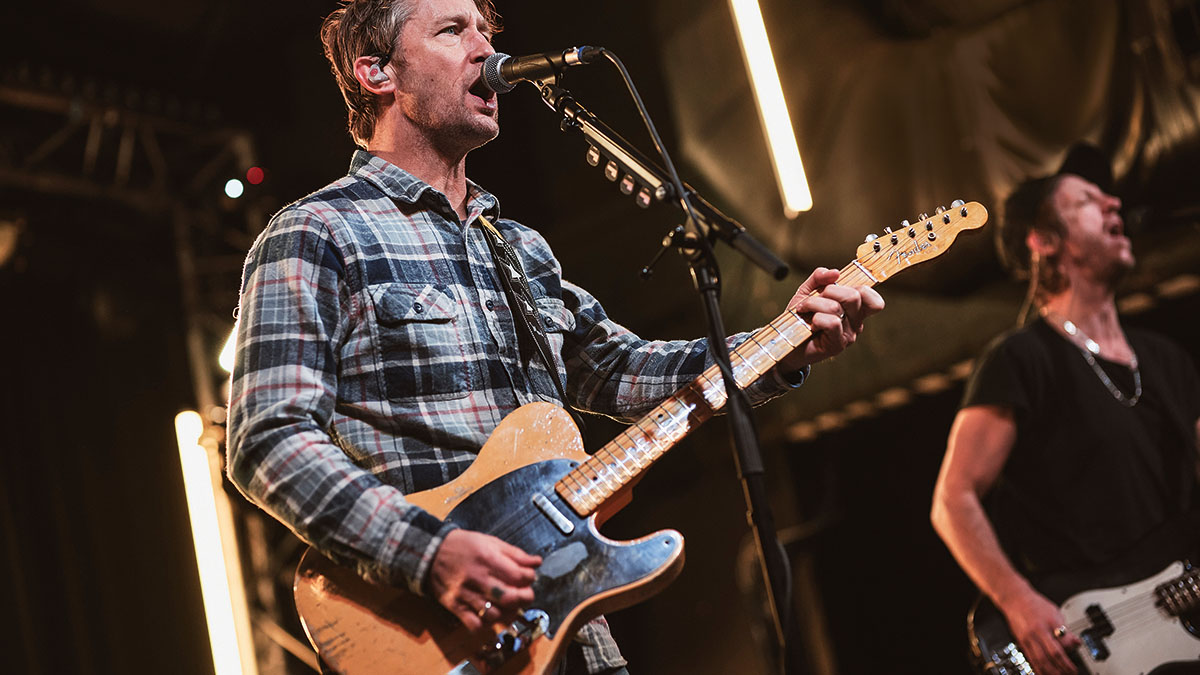
Tell us about your history with country music.
“I came to it through alt-country in the ’90s. Like, when Uncle Tupelo broke up and became Son Volt and Wilco, that was my jump-off. Through that, I found my way to Steve Earle, Lucinda Williams, then went back and landed on the other stuff.
“My favourite stuff is Buck Owens, Merle Haggard, Waylon Jennings, those older eras. Like a lot of people, I wrote off modern country for a long time, but I’ve totally flipped on that.
“Like, I listen to Eric Church and Brothers Osborne. I just love the storytelling. And obviously I fucking love the playing. Right about the time I came of age and started playing in bands, the kind of guitar playing I loved became pretty much illegal and you couldn’t play a long guitar solo any more. That kind of shifted to country and Americana and, to me, that’s where the best guitar playing lives nowadays.”
The slide work evokes Joe Walsh at times. Was he a touchstone?
“Sure. Weigh You Down, I played that slide solo. I Don’t Trust My Memories Anymore is the only B-Bender solo I did on the record. But if you’re thinking of the dobro on Dead And Gone, that’s Charlie Worsham. Basically, the breakdown on this record – there’s me playing electric and all the solos.
“But then, anything that’s acoustic – whether it’s guitar, mandolin, banjo, dobro – that’s all Charlie. Black Top [White Lines] and Dead And Gone have Tom Bukovac on electric. For the other eight songs, it was Nathan Keeterle playing the real vibed-out stuff, like the trippy delay and sonic textures.”
“I think of the stuff I played as the straightforward meat-and-potatoes, kinda bangin’ the chords. But then, we got Charlie and Nate bringing some details. For each song, we’d do about five takes and maybe Charlie would switch to different instruments, so by the time you start tracking, you’ve got a bunch of stuff to choose from. Then I would take the session home, overdub stuff, rework parts.
“I’ve never made a record like that before. But right about when I started this, in spring 2021, we started touring with Foos again, so there would be months on the road not even thinking about my record. Then I would come back to it when I had a minute at home, open the files and be like, ‘Oh yeah, we got some cool stuff here.’”
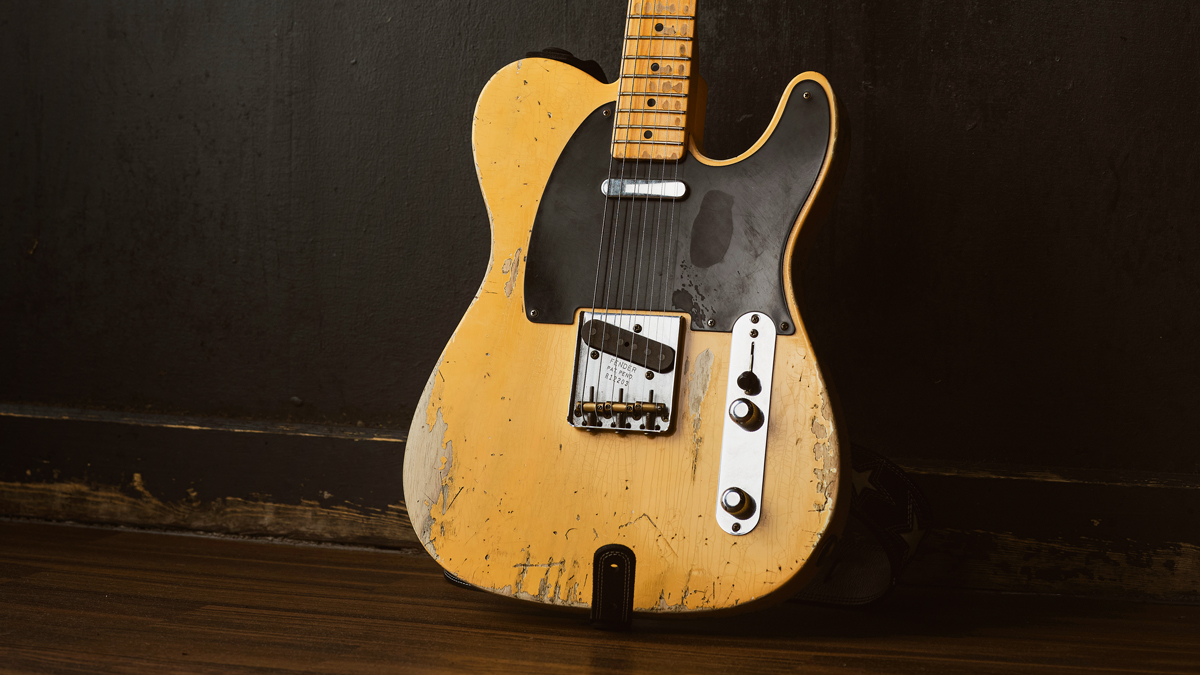
You have broad tastes in guitars, but your signature model is a Telecaster.
“The first real guitar I got was a Gibson Les Paul, for my 15th birthday. Through high school, then in bands coming up, through No Use For A Name, right up to joining Foo Fighters – that was the only guitar I had. I’d always played music that pretty much requires a humbucker sound, so that was my comfort zone for a long time.
“But I always wanted to play a Tele because I loved Keith Richards, The Clash and all these cats. But I was just never comfortable on them. Finally, I bought a Tele Deluxe. I loved it and played it a lot, from the time I made the first Dead Peasants record. But it wasn’t crunchy enough for Foos stuff. So I bought some Warmoth parts, put in humbuckers, put together a parts guitar.
“I built a couple of them, then Fender called me up and said, ‘Why don’t we just make a Chris Shiflett model?’ I hadn’t even thought of that. I just took that Deluxe, which I think was like a ’72, changed it to a four-bolt neck, with rosewood fretboard and humbuckers. There you go!”
I always wanted to play a Tele because I loved Keith Richards, The Clash and all these cats
Is there something about that combination of humbuckers and Fender scale that does something different for you?
“It’s, like, you can put humbuckers in a Strat or a Tele and it’s not gonna sound like a Les Paul or Flying V – it’s got its own colour, y’know? And that’s why it’s been a thing for me, especially in Foo Fighters. We’re a three-guitar band and we all sit in different places tonally. Around that time, I started playing through an AC30 a lot. I was always tweaking, trying to find something that sits in a different place.
“My signature Tele, it’s got that good rock crunch, but it’s not as dense a sound as a big Les Paul or 335. Those have a woofiness I love – but it’s not what my guitar does. And then, after that was when I started to get comfortable playing traditional Teles with just single coils. Which is pretty much all I do in my solo thing.”
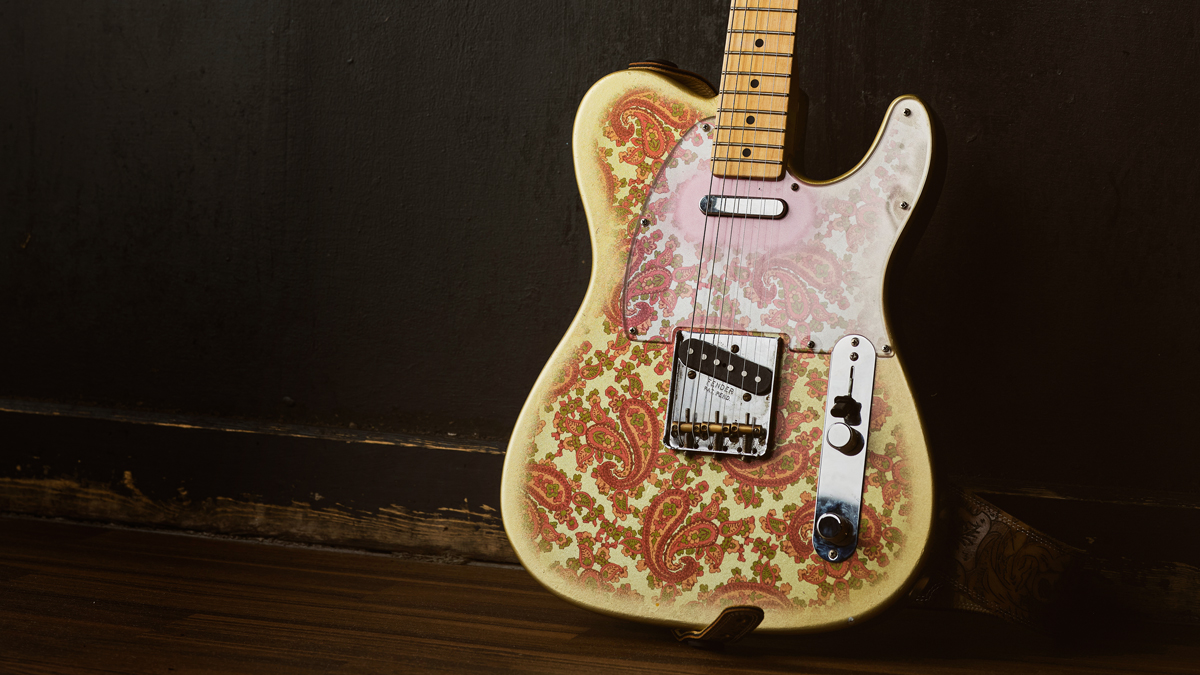
Let’s talk about the guitars you’ve brought out on tour.
“It’s a lean-and-mean rig. I would really prefer to have about four guitars, but I’m in a van schlepping this stuff around, so I figured I could pull it off on two and, knock on wood, it’s been fine so far. I’ve got two Teles. One is a Fender Custom Shop I bought at Gruhn’s in Nashville when I was there with the Foos recording Sonic Highways.
“It’s supposed to be a ’53 – just that classic Butterscotch Tele, with pretty hot pickups. That’s been my go-to Tele for quite a while, for my solo stuff. It’s almost the only guitar I used on this new album because I was flying into Nashville, so I’d just bring one guitar and my pedalboard, then Jaren would bring different amps.
“The other one I’ve brought is just a parts guitar – it says ‘Fender’ on it, but it’s not a real Fender. I found it at a shop down in Austin years ago and it’s beautiful. You know how Paisleys look when they fade and get that gold kind of colour? It sat in my garage for probably 10 years. It didn’t sound very good. Then I put in a set of Fralins – whatever their vintage Tele pickup is – and they just brought it to life. I haven’t been able to put it down since.”
You don’t seem to come across as a guitar snob…
“I mean, I am a guitar snob, in my own way. There’s a handful of things I love and then there’s a lot of shit that you’ll never see in my hands under any circumstances. But I don’t get too precious about guitars. If they feel good and sound good, then it sorta doesn’t matter. And when you’re taking things on the road, you want something you can drop, break and scratch – and not be too upset about it.
“I was never a vintage guy growing up. I don’t remember even hearing the words ‘vintage guitar’ until the ’90s, and I didn’t have money anyway, so you don’t worry about what you can’t afford. I always liked the idea of workhorse guitars you could put through their paces. But that started to change.
“I sold a bunch of guitars through Reverb and bought a ’57 Les Paul, which was a Goldtop originally, but somebody had taken the paint off. It’s not like I didn’t know vintage guitars were great – but actually owning something of that vintage, it was like, ‘Okay, I see what everybody is raving about.’”
I actually have a beautiful Masterbuilt White Falcon. I so badly wanted to bring it out for the solo tours. But I’m just afraid: I don’t even want to nick the case!
What do you pick up a Gretsch for, and what’s your relationship with that brand?
“I actually have a beautiful Masterbuilt White Falcon. I so badly wanted to bring it out for the solo tours. But I’m just afraid: I don’t even want to nick the case! I could play my whole set on that thing, for sure. It’s got a jangle and growl, all at the same time. If you want high-gain stuff, it works really well. And if you want a cleaner old-school sound, you can’t go wrong.
“I was a rock ’n’ roll kid, listening to whatever my brothers had in their record collections: Aerosmith, Stones, Zeppelin, KISS. But when Stray Cats came along, that was the one non-rock band I was obsessed with. I’ve always loved Brian Setzer’s playing and was drawn to Gretsches because of him.”
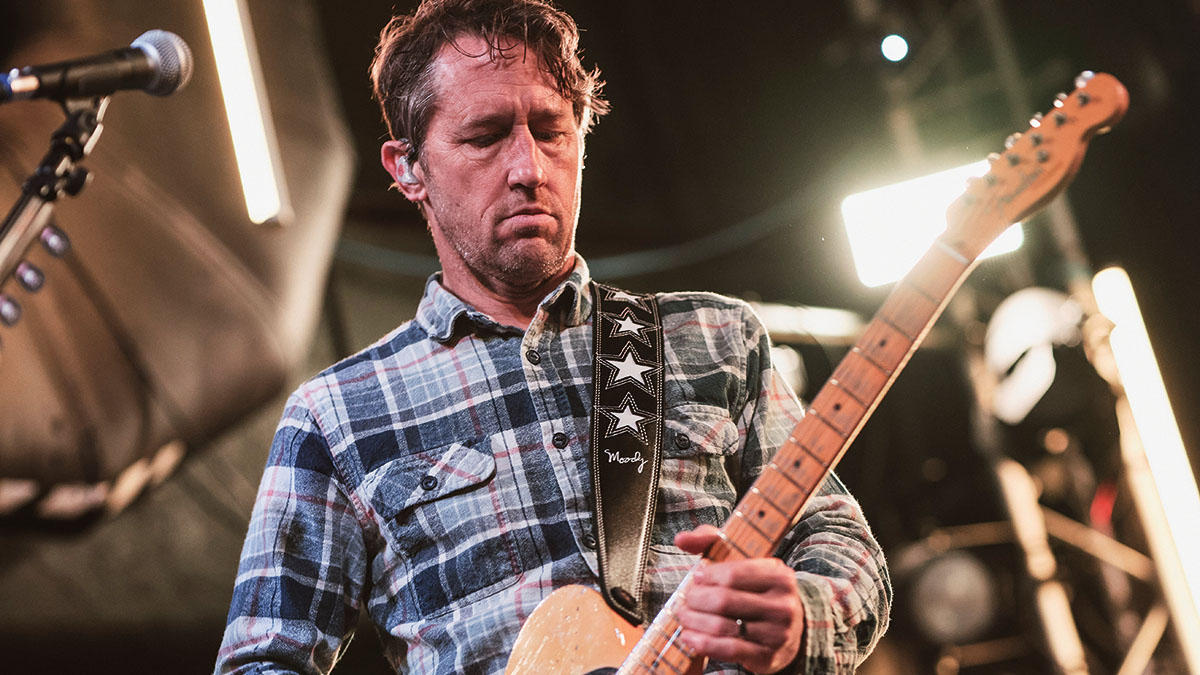
You’re now using a Strymon Iridium amp modeller for your solo shows.
“It feels like total blasphemy! But doing my solo shows, I play a lot of shitty bars with shitty PAs, and oftentimes I’m not travelling with my own sound man and it’s a real roll of the dice – sometimes it’s great and sometimes it’s fucking terrible.
More often than not, with my favorite rock solos, like Eddie Van Halen solos, they’re kinda like parts and melodies unto themselves within the song
“I just found that dragging around my old combo amps – because I normally play through a Deluxe Reverb or old Princeton – they’re so susceptible to dirty power and things colouring your tone. And then, having people mic them: I just never liked the way they sounded coming back. It drives me crazy. I mean, I don’t want to shit on any local sound person, but when you don’t have somebody who really gives a shit and knows what they’re doing putting your sound together, it’s fucking horrible and a vibe-killer.
“I’d bought one of those Iridiums to fuck around with in my studio and just loved the way it sounded. Live, it just cuts out the middle man.”
Do you have an ethos when it comes to soloing?
“Most of the time, I work it out before I even get to the studio. But it really depends on the song. I like noodly shreddy-spaghetti solos where you just play whatever the fuck you want. But more often than not, with my favourite rock solos, like Eddie Van Halen solos, they’re kinda like parts and melodies unto themselves within the song.”
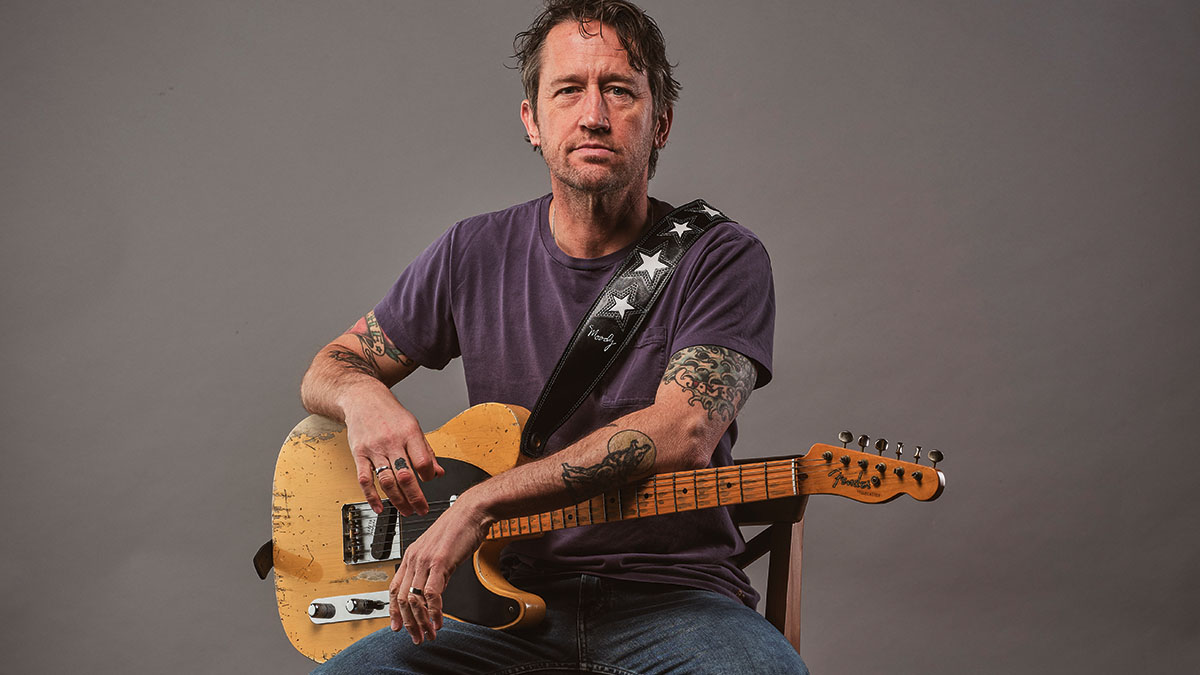
As an artist, do you ever question what you’re doing?
“I think most musicians are battling insecurity on some level. It’s funny because musicians are all narcissists, too. It does take some ego to say, ‘This is my idea, listen to it!’ The hardest thing with performing is not letting the devil get in your head. It can be the best fucking crowd and there’s one guy at the back laughing – and that fucks up your whole thing. It’s nuts, y’know?
“And the thing that fucks me up the most was in my younger years playing in No Use For A Name, where the barometer for whether it was a good gig was how hard the crowd danced and how wild the pit was. That ruined me for the rest of my life because I don’t play music that garners that reaction. You just try to keep the dark thoughts out when you’re on stage.”
So what’s next for you?
“I want to get back over to the UK before too long. With Foos, we’ve got touring [through to January]. Beyond that, it’s like, I’m a fucking musician – so who knows what will happen? I gave up trying to even think about it because after these last two years, it’s like the world has a funny way of changing your plans.”
Chris Shiflett’s pedalboard and guitar amps

Take a tour of Chris Shiflett’s solo pedalboard and you’ll find this sometime punk isn’t shy of a stompbox, with his collection spanning from MXR’s Phase 95 to the DigiTech Drop and Wampler Tumnus. But the biggest departure in his modern club-show rig, the guitarist reminds us, is the absence of the traditional backline mothership.
“Oh, man, this setup that I’m playing with now is so crazy. I just got one of those GigRig G3 channel switchers, and I’m not even playing through an amp right now – I’ve got a Strymon Iridium instead. You can arrange it however you want, but I have it so it’s all the effects first and then a Strymon Deco, then the Iridium, the Strymon TimeLine and the Strymon Flint. And then I have it coming out stereo on one of those Walrus Canvas DIs.”
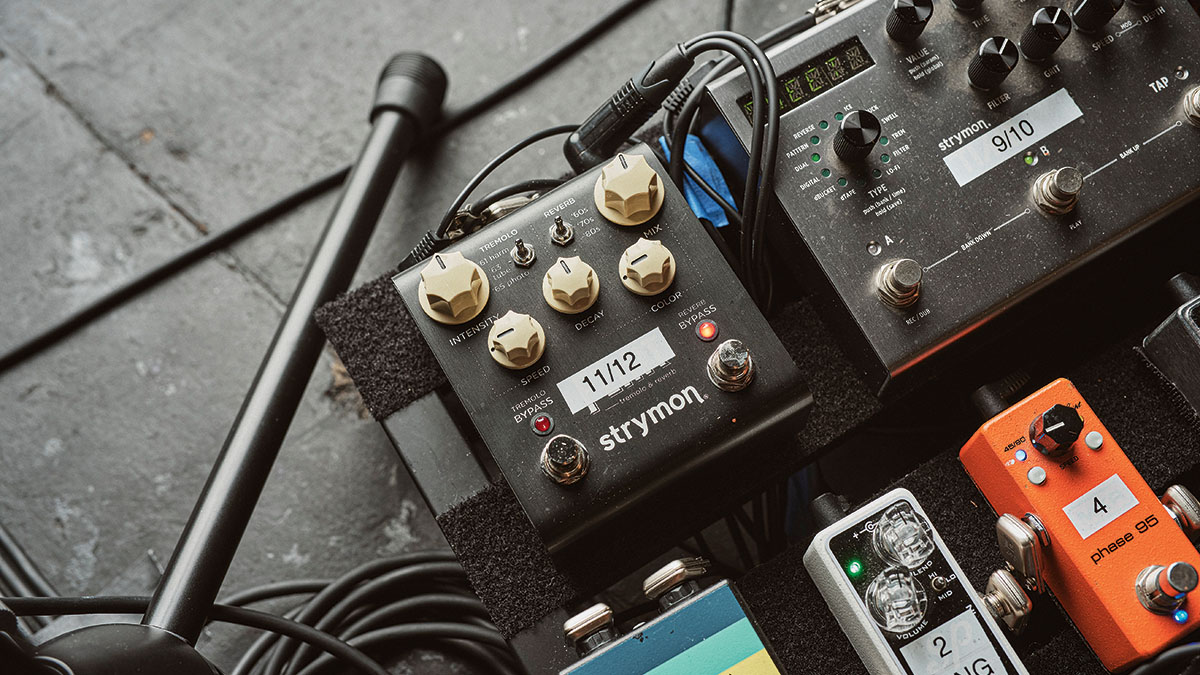
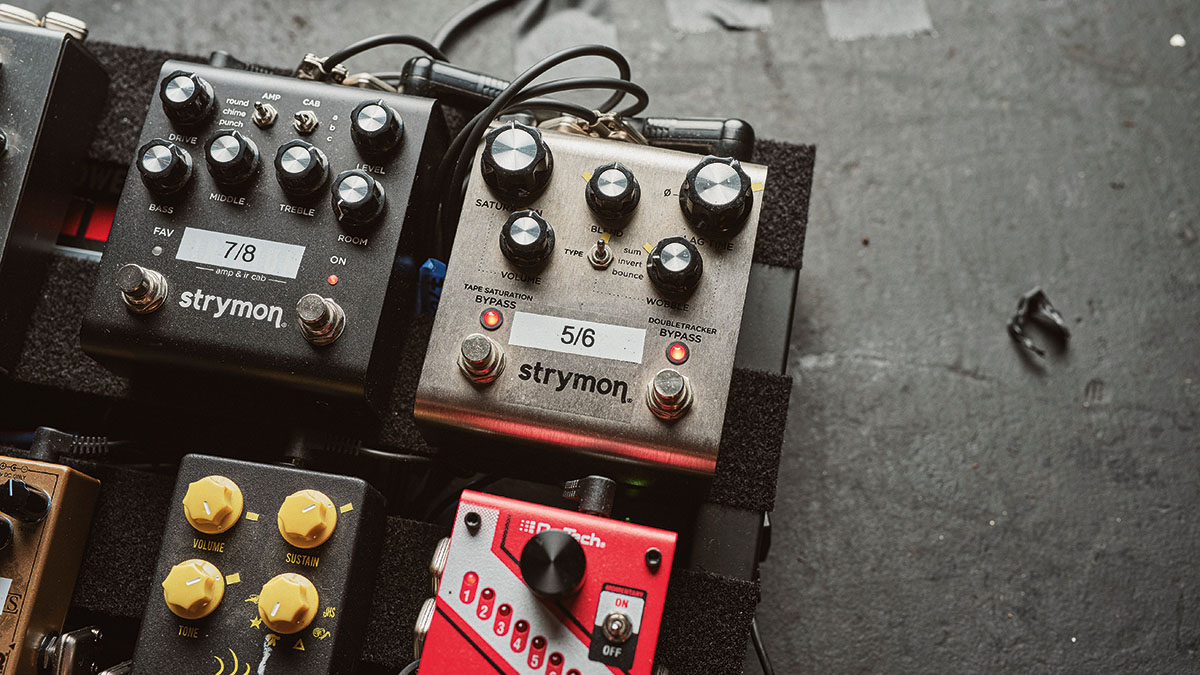
Isn’t the Iridium a big departure for a tube amp aficionado? “100 per cent,” nods Shiflett. “Of course, my preference would be a wall of amps. They’re beautiful and everything. But you’re hemmed in with budgetary realities in this solo thing, y’know?
“And just to know that every night, the tone is gonna be unaffected by power or air in the room or somebody’s bad EQ-ing. I mean, I guess it still could be, but you know what I mean – it’s just a little more direct, a little easier with the Iridium. And those things sound fucking great, man, they really do.”
Follow Chris Shiflett in all his forms and you’ll notice that the stripped minimalism of his solo rig gets a shot of steroids when he steps back onto the stadium circuit. “My Foo Fighters setup is a very different animal,” explains the guitarist. “I have two Friedman half-stacks.
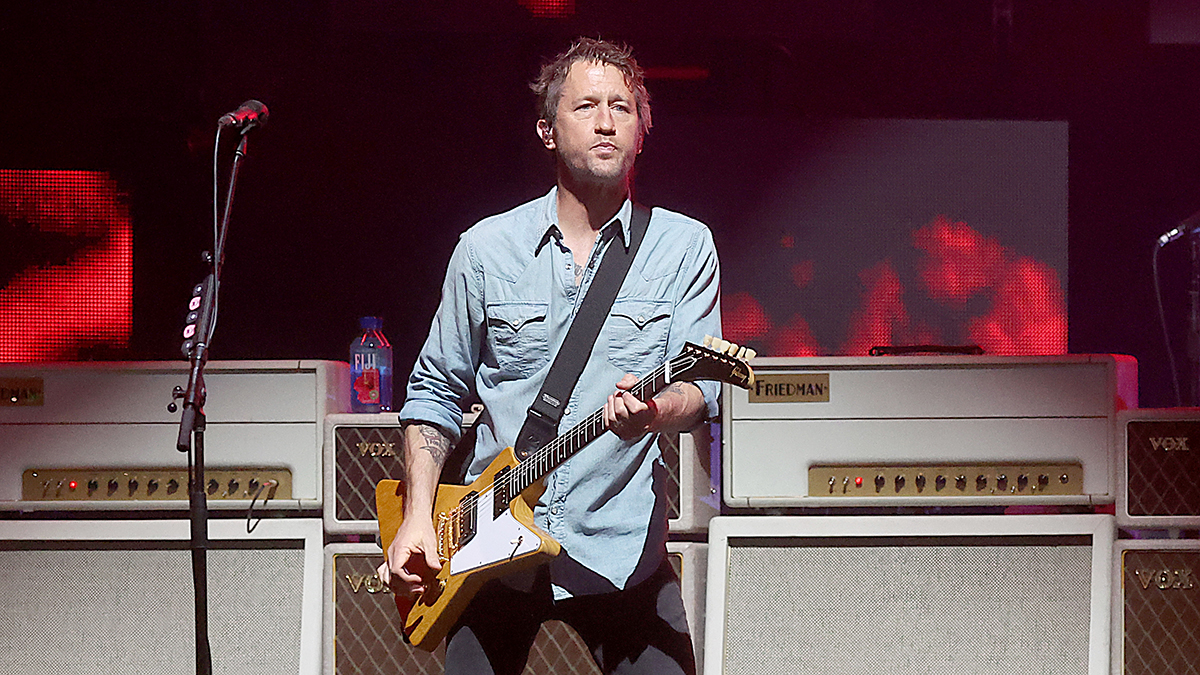
“I have the Brown Eye, most people call them ‘BE’ or whatever. I bought mine years ago now. I can’t remember if it was the Wasting Light or Sonic Highways tour, but I’ve had them for a long time. They’re practically vintage now – just a few more years! So I don’t know if those amps have evolved since I bought mine, but I love them. That’s my favourite, y’know, that Marshally-type sound.
“Alongside the Friedmans,” he continues, “I also have two AC30 half-stacks and I A/B them. And then Dave Friedman literally just built me a new pedalboard setup, so I’m using one of those RJM controllers. I haven’t even seen it yet – it just arrived after I left for the UK – but my tech has been sending me photos and he says it sounds great. And then I bring that ’57 Goldtop on the road with the Foo Fighters, too. You’ve got to play old guitars or they start to get wonky.
“So that setup is a very different beast to my solo rig,” smiles Shiflett. “That’s the kind of beast you have when somebody carries your shit around for you...!”
- Lost at Sea is out now via Blue Elan.
Henry Yates is a freelance journalist who has written about music for titles including The Guardian, Telegraph, NME, Classic Rock, Guitarist, Total Guitar and Metal Hammer. He is the author of Walter Trout's official biography, Rescued From Reality, a talking head on Times Radio and an interviewer who has spoken to Brian May, Jimmy Page, Ozzy Osbourne, Ronnie Wood, Dave Grohl and many more. As a guitarist with three decades' experience, he mostly plays a Fender Telecaster and Gibson Les Paul.

